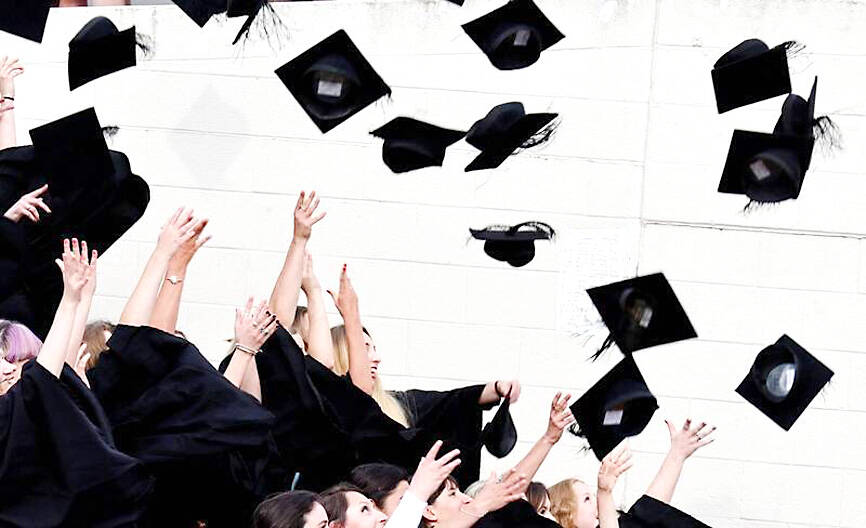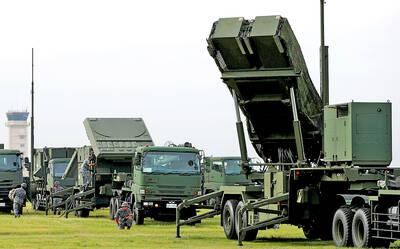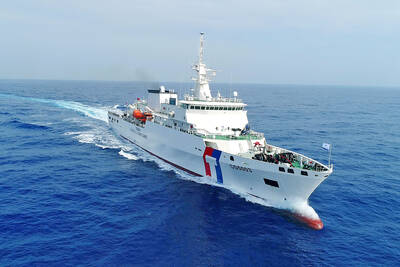Taiwan was the fifth-largest source of international students in the US during the last academic year, trailing only India, China, South Korea and Canada, a US Department of State report released on Monday showed.
The number of Taiwanese students in the US during the 2023-2024 school year rose 6.1 percent from a year earlier to 23,157, accounting for 2.1 percent of the total, data from the 2024 Open Doors Report on International Educational Exchange showed.
That continued a trend of annual increases that began in 2015, pausing only from 2019 to 2021 due to the COVID-19 pandemic, and made Taiwan the fifth-largest sender of international students to the US, vaulting it past Vietnam, which ranked sixth.

Photo: Reuters
India and China combined to account for more than half of the international students in the US.
The annual report, issued by the department’s Bureau of Educational and Cultural Affairs and the nonprofit Institute of International Education, defines international students as those enrolled at US higher education institutions or engaged in optional practical training (OPT).
OPT refers to temporary employment programs for foreign students related to their area of study.
The largest group of Taiwanese students in the US (43.1 percent) in the 2023-2024 academic year were enrolled in graduate programs, with Taiwan ranking as the eighth-largest foreign source of graduate students.
Another 24 percent of Taiwanese students were enrolled in undergraduate programs, and 28 percent participated in OPT programs, an increase of 27.4 percent, making Taiwan the fourth-largest source of international OPT students.
Meanwhile, 4.5 percent of Taiwanese students were enrolled in non-degree programs, up 22.8 percent from the previous year, it said.
The release of the Open Doors Report is part of the annual International Education Week, a joint initiative of the State Department and the US Department of Education, to promote international educational exchange.
From Monday to Friday, the American Institute in Taiwan has arranged events across Taiwan to promote studying in the US, including seminars, a virtual education fair and a six-video series featuring Taiwanese studying or working in the US.
Ministry of Education data showed that 56,798 Taiwanese were studying abroad during the 2022-2023 academic year, with the largest share — 26,082 — enrolled in the Americas, including 21,834 in the US and 4,240 in Canada.
There were also 11,161 Taiwanese studying in Oceania countries, mainly in Australia, with 10,673 students.
There were 10,841 Taiwanese students in Europe, mostly in the UK, with 3,685, followed by 2,868 in Germany, 744 in Poland, 690 in Spain and 664 in the Netherlands.
Of the 8,710 Taiwanese studying in Asian countries, 5,015 were enrolled in Japan and 2,172 were studying in South Korea.
China was not listed among the Asian countries in the table.
The numbers of students in each country were also from slightly different statistical periods, ranging between 2021 and last year, but mostly in 2022 and last year, as the numbers were collected individually from each country, the ministry said.
Additional reporting by Lee I-chia

MILITARY BOOST: The procurement was planned after Washington recommended that Taiwan increase its stock of air defense missiles, a defense official said yesterday Taiwan is planning to order an additional four PAC-3 MSE systems and up to 500 missiles in response to an increasing number of missile sites on China’s east coast, a defense official said yesterday. The official, who spoke on condition of anonymity, said that the proposed order would be placed using the defense procurement special budget, adding that about NT$1 trillion (US$32,88 billion) has been allocated for the budget. The proposed acquisition would include launchers, missiles, and a lower tier air and missile defense radar system, they said The procurement was planned after the US military recommended that Taiwan increase

POLITICAL AGENDA: Beijing’s cross-strait Mid-Autumn Festival events are part of a ‘cultural united front’ aimed at promoting unification with Taiwan, academics said Local authorities in China have been inviting Taiwanese to participate in cross-strait Mid-Autumn Festival celebrations centered around ideals of “family and nation,” a move Taiwanese academics said politicizes the holiday to promote the idea of “one family” across the Taiwan Strait. Sources said that China’s Fujian Provincial Government is organizing about 20 cross-strait-themed events in cities including Quanzhou, Nanping, Sanming and Zhangzhou. In Zhangzhou, a festival scheduled for Wednesday is to showcase Minnan-language songs and budaixi (布袋戲) glove puppetry to highlight cultural similarities between Taiwan and the region. Elsewhere, Jiangsu Province is hosting more than 10 similar celebrations in Taizhou, Changzhou, Suzhou,

TWO HEAVYWEIGHTS: Trump and Xi respect each other, are in a unique position to do something great, and they want to do that together, the US envoy to China said The administration of US President Donald Trump has told Chinese President Xi Jinping (習近平) “we don’t want any coercion, but we want [the Taiwan dispute] resolved peacefully,” US ambassador to China David Perdue said in a TV interview on Thursday. Trump “has said very clearly, we are not changing the ‘one China’ policy, we are going to adhere to the Taiwan Relations Act, the three communiques and the ‘six assurances’ that were done under [former US president Ronald] Reagan,” Perdue told Joe Kernen, cohost of CNBC’s Squawk Box. The act, the Three Joint Communiques and the “six assurances” are guidelines for Washington

DEEPENING TIES: The two are boosting cooperation in response to China’s coercive actions and have signed MOUs on search-and-rescue and anti-smuggling efforts Taiwan and Japan are moving to normalize joint coast guard training and considering the inclusion of other allies, the Japanese Yomiuri Shimbun reported yesterday. Both nations’ coast guards in June sent vessels to the seas south of the Sakishima Islands to conduct joint training, the report said, adding that it was the second joint maritime training exercise since the nations severed formal diplomatic ties in September 1972. Japan dispatched the Nagoya Coast Guard’s Mizuho, a 134m, 6,000-tonne patrol vessel which can carry a helicopter, while the Coast Guard Administration (CGA) sent the 126m, 4,000-tonne Yunlin, one of its largest vessels, the report